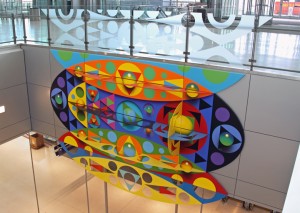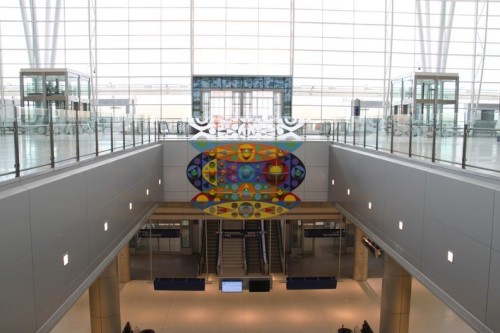
When they opened the new terminal building in 2008, officials at the Indianapolis International Airport (IND) boasted of spending millions of dollars on artwork that included 36 site-specific, permanent pieces that were “intended to serve as a visual gateway to the city.”
But now one of those permanent” pieces – James Wille Faust’s multi-story sculptural painting titled “Chrysalis” is being taken down and replaced with a video wall that will used for advertising and electronic art.
The airport is trying to find a “tasteful balance” between competing interests for advertising income and art and has hired the consulting arm of the Indianapolis Museum of Art (IMA) to help develop a new public art plan, said Carlo Bertolini, director of communications at Indianapolis Airport Authority. “We’ll reveal details about that plan in a few weeks,” he said. “In the meantime, an opportunity was presented to us some time ago to incorporate a video wall in that space and we thought it made sense.”
But the idea doesn’t make sense to some of the commissioned artists and to many local and national arts supporters.
“If the airport wants to present Indiana as a cultural destination and highlight local and national artists, this is the wrong message to be sending out,” said Valerie Eickmeier, dean of the Herron School of Art and Design in Indianapolis. “It’s just kind of insulting to the artist to have work taken down because of an advertising opportunity.”
“I feel [Faust’s] pain,” said Brooklyn-based artist Ron Baron, who created “Baggage Claim,” using suitcases and a miniature diorama of baggage handlers and travelers, specifically for the airport’s baggage claim area. “It’s a slap in the face. Especially because when the building opened there was so much hoopla and celebration of the art and the artists. The irony here is that the museum is involved and they of all people should understand the importance of site-specific art. Now I’m worried what will happen to my art.”
While controversial, airport officials can legally do as they please. As is common in commissioning contracts for public art, the airport reserved the right to remove the pieces. “The artists knew that,” said Julia Moore, the public art administrator at Blackburn Architects, the firm that oversaw the selection of artists and artwork for the terminal. “But I don’t think they knew or thought that less than three years after the airport opened, the airport authority would just change its mind about what they wanted in this prominent spot.”
Moore echoes the comments of others who find it ironic that Faust’s work is being removed in consultation with the IMA. “You’d expect the museum to come down on the side of art,” she said. “The key is going to be what’s going to be there. Is it going to be mostly advertising or mostly art? Or mostly art until advertisers want the spot?”
For its part, the airport authority offered to move Faust’s “Chrysalis” piece to another public building in town. But because the piece was designed specifically for its spot at the airport and “removing, modifying and re-installing the artwork to another location would compromise the integrity” of his work, Faust declined.
Instead, the piece will be stored away.

Photos courtesy James Wille Faust
A slightly different version of this story first appeared on msnbc.com’s Overhead Bin.